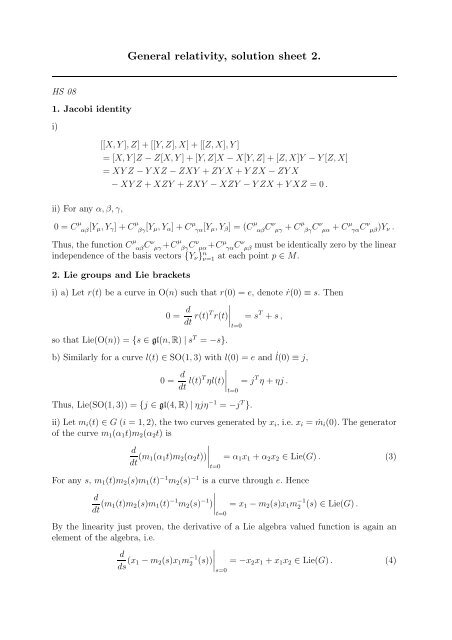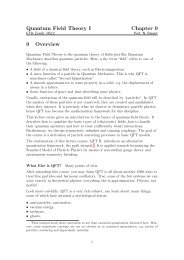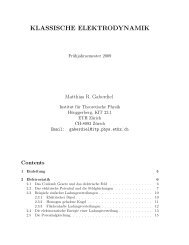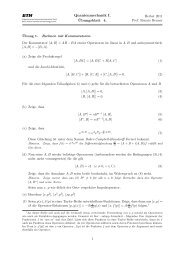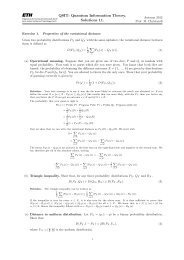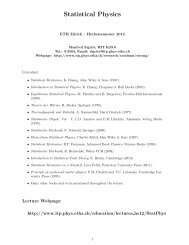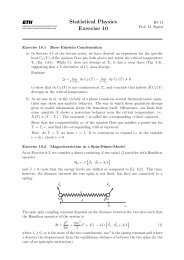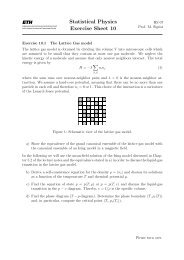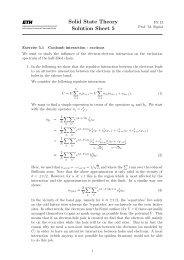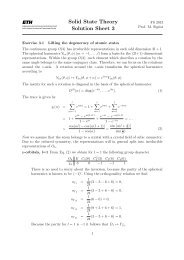General relativity, solution sheet 2.
General relativity, solution sheet 2.
General relativity, solution sheet 2.
You also want an ePaper? Increase the reach of your titles
YUMPU automatically turns print PDFs into web optimized ePapers that Google loves.
<strong>General</strong> <strong>relativity</strong>, <strong>solution</strong> <strong>sheet</strong> <strong>2.</strong><br />
HS 08<br />
1. Jacobi identity<br />
i)<br />
ii) For any α, β, γ,<br />
[[X, Y ], Z] + [[Y, Z], X] + [[Z, X], Y ]<br />
= [X, Y ]Z − Z[X, Y ] + [Y, Z]X − X[Y, Z] + [Z, X]Y − Y [Z, X]<br />
= XY Z − Y XZ − ZXY + ZY X + Y ZX − ZY X<br />
− XY Z + XZY + ZXY − XZY − Y ZX + Y XZ = 0 .<br />
0 = C µ αβ [Y µ, Y γ ] + C µ βγ [Y µ, Y α ] + C µ γα [Y µ, Y β ] = (C µ αβ Cν µγ + Cµ βγ Cν µα + Cµ γα Cν µβ )Y ν .<br />
Thus, the function C µ αβ Cν µγ +C µ βγ Cν µα+C µ γαC ν µβ must be identically zero by the linear<br />
independence of the basis vectors {Y ν } n ν=1 at each point p ∈ M.<br />
<strong>2.</strong> Lie groups and Lie brackets<br />
i) a) Let r(t) be a curve in O(n) such that r(0) = e, denote ṙ(0) ≡ s. Then<br />
0 = d dt r(t)T r(t)<br />
∣ = s T + s ,<br />
t=0<br />
so that Lie(O(n)) = {s ∈ gl(n, R) | s T = −s}.<br />
b) Similarly for a curve l(t) ∈ SO(1, 3) with l(0) = e and ˙l(0) ≡ j,<br />
0 = d dt l(t)T ηl(t)<br />
∣ = j T η + ηj .<br />
t=0<br />
Thus, Lie(SO(1, 3)) = {j ∈ gl(4, R) | ηjη −1 = −j T }.<br />
ii) Let m i (t) ∈ G (i = 1, 2), the two curves generated by x i , i.e. x i = ṁ i (0). The generator<br />
of the curve m 1 (α 1 t)m 2 (α 2 t) is<br />
d<br />
dt (m 1(α 1 t)m 2 (α 2 t))<br />
∣ = α 1 x 1 + α 2 x 2 ∈ Lie(G) . (3)<br />
t=0<br />
For any s, m 1 (t)m 2 (s)m 1 (t) −1 m 2 (s) −1 is a curve through e. Hence<br />
d<br />
dt (m 1(t)m 2 (s)m 1 (t) −1 m 2 (s) −1 )<br />
∣ = x 1 − m 2 (s)x 1 m −1<br />
2 (s) ∈ Lie(G) .<br />
t=0<br />
By the linearity just proven, the derivative of a Lie algebra valued function is again an<br />
element of the algebra, i.e.<br />
d<br />
ds (x 1 − m 2 (s)x 1 m −1<br />
2 (s)) ∣<br />
∣∣∣s=0<br />
= −x 2 x 1 + x 1 x 2 ∈ Lie(G) . (4)
Finally, (4) follows from (2,3) and the distributivity for n × n matrices.<br />
iii) It follows from ϕ ∗ [X, Y ] = [ϕ ∗ X, ϕ ∗ Y ], see lecture notes p.7, that<br />
(λ g ) ∗ [X, Y ] = [X, Y ]<br />
for any two left-invariant vector fields X, Y .<br />
iv) Applying (λ g ) ∗ to (1) gives<br />
[Y α , Y β ] = (λ g ) ∗ (C γ αβ Y γ) = (C γ αβ ◦ λ g)Y γ .<br />
Comparison with (1) yields, by the independence of the Y γ , C γ αβ ◦ λ g<br />
C γ αβ (gh) = Cγ αβ (h). Hence Cγ αβ<br />
is constant.<br />
= C γ αβ , i.e.<br />
v) Left-invariance means X gh = (λ g ) ∗ X h . For h = e this shows that X e ∈ T e (G) = Lie(G)<br />
determines X g at all g ∈ G.<br />
vi) Let us first recall that the relation X ↔ x between the (abstract) left-invariant vector<br />
field X and its matrix form x is<br />
(Xf)(e) = d dt f(m(t)) ∣<br />
∣∣∣t=0<br />
, (f ∈ F(G)) ,<br />
where ṁ(0) = x. Hence α 1 x 1 + α 2 x 2 corresponds to (see (3))<br />
d<br />
dt f(m 1(α 1 t)m 2 (α 2 t))<br />
∣ = d t=0<br />
dt f(m 1(α 1 t))<br />
∣ + d t=0<br />
dt f(m 2(α 2 t)) ∣<br />
= α 1 (X 1 f)(e) + α 2 (X 2 f)(e) ,<br />
by using the chain rule, i.e., to α 1 X 1 + α 2 X 2 . To establish the second correspondence<br />
consider the conjugation τ h : G → G, g ↦→ hgh −1 . One verifies λ g ◦ τ h = τ h ◦ λ h −1 gh,<br />
implying (λ g ) ∗ (τ h ) ∗ = (τ h ) ∗ (λ h −1 gh) ∗ . Hence (τ h∗ )X is left-invariant if X is; moreover<br />
(τ h∗ )X ↔ hxh −1 because<br />
d<br />
dt f(hm(t)h−1 )<br />
∣ = d t=0<br />
dt (f ◦ τ h)(m(t))<br />
∣ = (τ h∗ Xf)(e) (5)<br />
t=0<br />
by the definition of the tangent map. In particular<br />
(τ m2 (s)) ∗ X 1 ←→ m 2 (s)x 1 m 2 (s) −1<br />
and by the already established linearity of the correspondence it extends to the derivative<br />
w.r.t. s. On the l.h.s we have by (5)<br />
d<br />
ds τ m 2 (s)∗X 1 f(e)<br />
∣ = d d<br />
s=0<br />
ds dt f(m 2(s)m 1 (t)m 2 (s) −1 )<br />
∣<br />
s=t=0<br />
= d d f(m2 (s)m 1 (t)) + f(m 1 (t)m 2 (s)<br />
ds dt( −1 ) )∣ ∣∣s=t=0<br />
= d ds X 1(f ◦ λ m2 (s))(e)<br />
∣ − d s=0<br />
dt X 2(f ◦ λ m1 (t))(e) ∣<br />
= ((X 1 X 2 − X 2 X 1 )f)(e) ,<br />
∣<br />
t=0<br />
∣<br />
t=0
i.e.<br />
On the r.h.s. we have, see (4)<br />
d<br />
ds τ m(s)∗X 1<br />
∣<br />
∣∣∣s=0<br />
= [X 1 , X 2 ] .<br />
d<br />
ds m 2(s)x 1 m 2 (s) −1 ∣<br />
∣∣∣s=0<br />
= [x 1 , x 2 ] .


